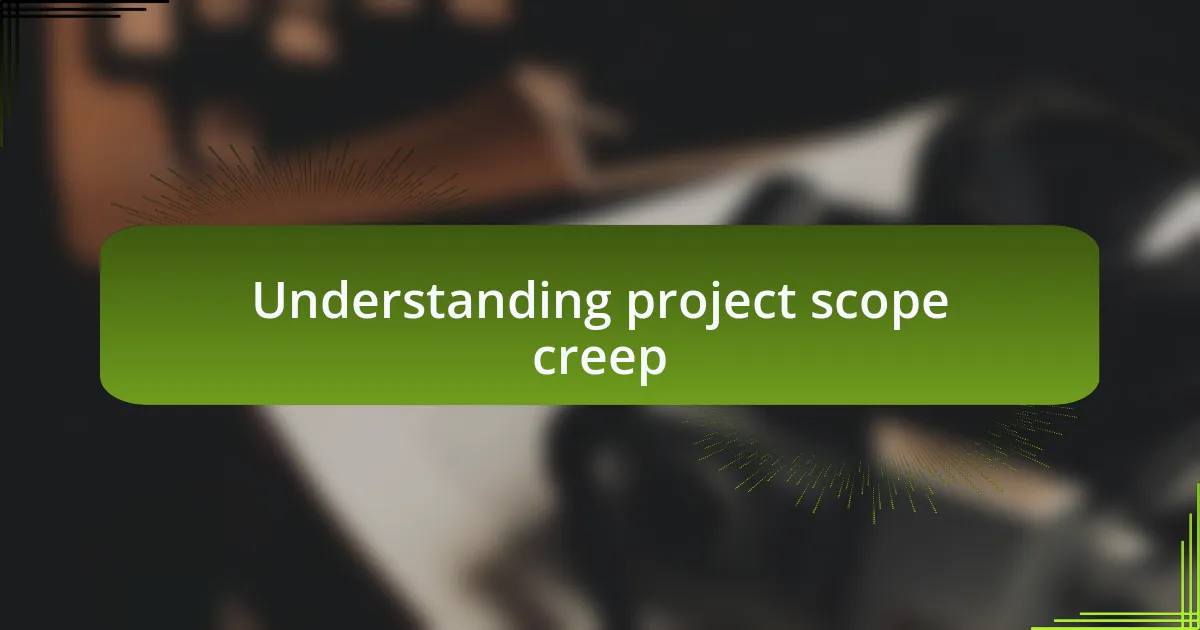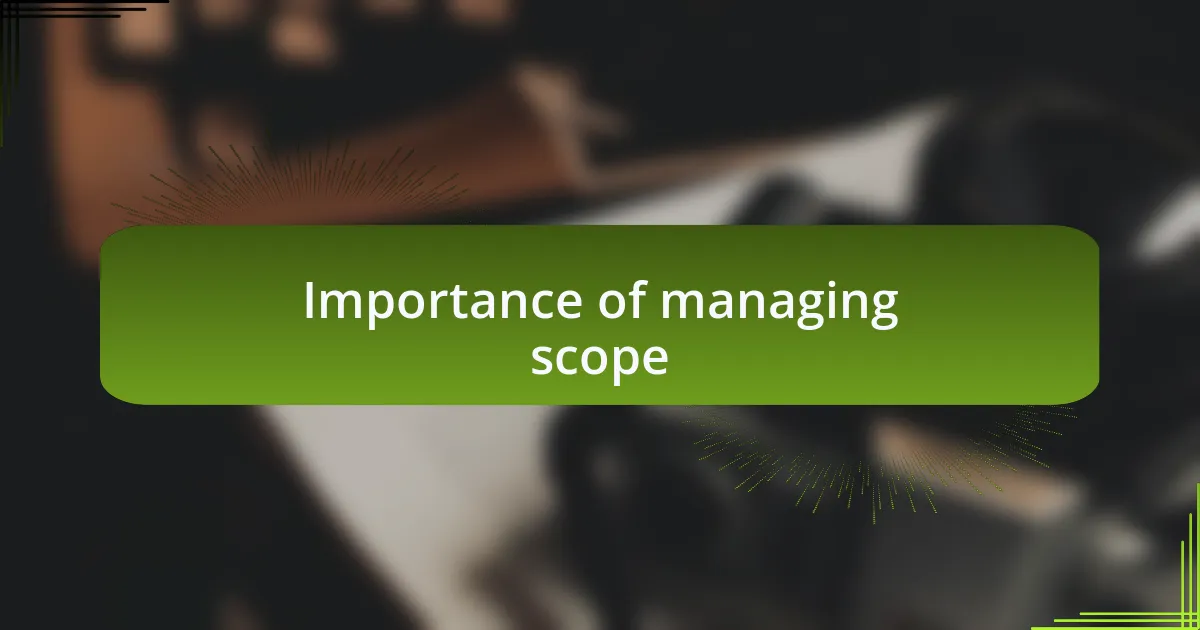Key takeaways:
- Project scope creep involves expanding project parameters beyond original objectives, often due to insufficiently defined requirements or ongoing stakeholder requests.
- Effective scope management maintains focus on primary goals, enhances client satisfaction, and reduces team stress by establishing clear boundaries and expectations.
- Key strategies to prevent scope creep include detailed initial planning, regular stakeholder engagement, and using project management tools for transparency and accountability.
- Encouraging flexibility while adhering to scope and creating a robust change request process can help mitigate the negative impacts of unvetted changes on project timelines.

Understanding project scope creep
Project scope creep refers to the gradual expansion of a project’s parameters beyond its original objectives. I remember a project where a client kept suggesting additional features, thinking they’d enhance the final product. It made me wonder—how do we define “done” when new ideas keep bubbling up?
In my experience, it’s essential to recognize the fine line between improvement and distraction. One time, I learned this the hard way when a simple website redesign turned into a massive overhaul. That journey taught me that unchecked changes can lead to frustration—not just for the team, but for the clients as well. It’s crucial to manage expectations and communicate clearly.
Understanding project scope creep also involves acknowledging the emotional toll it can take on everyone involved. I’ve felt the tension that arises when deadlines loom and new requests flood in. This raises a vital question: how do we balance innovation with the necessity to stay on course? I believe it starts with establishing firm boundaries at the project’s outset and revisiting them regularly.

Importance of managing scope
Managing scope effectively is crucial because it helps maintain focus on the project’s primary goals, avoiding unnecessary distractions. I once found myself in a situation where my team was excited about exploring new functionalities, but without a clear scope, we ended up diverting our attention from essential tasks. It made me realize that clarity truly is power in project management.
Moreover, scope management directly impacts client satisfaction. I recall a project where we successfully set clear expectations from the start, which led to enhanced trust with the client. When they saw our commitment to the original vision, it not only strengthened our relationship but also assured them that their investment was being respected. Isn’t it interesting how setting proper boundaries can actually foster creativity rather than stifle it?
Finally, I’ve learned that a well-defined project scope can significantly reduce stress for the entire team. When we know what to expect, it creates a more structured environment where everyone can thrive. I vividly remember feeling overwhelmed in a project that drifted off course due to scope creep; the pressure was palpable. In contrast, having a clearly communicated scope feels like sailing with a steady wind at your back, guiding us toward success.

Common causes of scope creep
One of the most common causes of scope creep is insufficiently defined project requirements. In my experience, projects often start with excitement and vague ideas, but without concrete specifications, each team member may interpret the goals differently. Have you ever found yourself in a meeting where everyone seemed on the same page, only to realize later that the very foundation of the project was shaky? I certainly have, and it felt like building a house on sand.
Another culprit behind scope creep is stakeholder changes or new requests throughout the project’s lifecycle. Each time a stakeholder hints at a “small” addition or modification, it can feel manageable in isolation, yet those little tweaks add up quickly. I remember a project where a seemingly minor request from a stakeholder turned into a major feature that diverted our entire timeline. It made me question how often we truly assess the implications of these requests.
Finally, poor communication among team members can significantly contribute to scope creep. I once worked on a project where updates were shared sporadically, leading to misunderstandings about what was completed versus what was still needed. The frustration of discovering that we were not aligned was palpable, and it underscored the importance of maintaining clear channels of communication. Have you felt the tension when misaligned efforts collide? It’s a reminder that clarity in communication is just as critical as clarity in scope.

Strategies to prevent scope creep
One effective strategy to prevent scope creep is establishing a clear and detailed project scope from the outset. I recall a project where we dedicated extra time to outline specific deliverables, timelines, and expectations, and it paid off massively. Have you ever navigated a project where every team member knew precisely their role? It transforms the workflow, reducing misunderstandings and misaligned expectations right from the beginning.
Regular stakeholder engagement is also crucial in keeping scope creep at bay. I’ve found that scheduling routine check-ins with stakeholders helps to manage their expectations and allows for a more controlled introduction of changes. There was a time when I organized bi-weekly meetings, and it created an open dialogue where stakeholders felt heard without derailing the project’s progress. Isn’t it comforting to know that proactive communication can keep everyone aligned and committed to the original goals?
Finally, utilizing project management tools can foster transparency and accountability among team members. In one of my projects, we adopted a collaborative platform where progress was visibly tracked. This not only kept every team member informed but also created a sense of ownership that motivated everyone to adhere closely to the defined scope. Isn’t it fascinating how the right tools can promote discipline and reduce the risk of veering off course?

Advice for future projects
When embarking on future projects, I strongly recommend investing time in upfront planning. In one instance, I underestimated how crucial this was and jumped straight into execution. The resulting chaos taught me that taking the time to thoroughly define a project’s objectives can save countless hours of rework down the line. Do you really want to dig yourself out of a mess when a little planning could have made all the difference?
Another piece of advice is to encourage a culture of flexibility among your team while reinforcing the importance of adhering to scope. In a recent project, I encouraged my team to openly discuss potential changes and their impacts during our daily stand-ups. This approach not only made everyone feel valued but also fostered a proactive mindset, allowing us to evaluate scope adjustments without compromising the project’s integrity. How often do we forget to check in with our team about their feelings on proposed changes?
Lastly, it’s essential to create a robust process for managing change requests. I vividly remember a project where a single change led to cascading adjustments that considerably delayed our timeline. Implementing a formal review process for these requests helped us determine their necessity and potential impact more objectively. Have you experienced the frustration of a project dragged down by unvetted changes? Establishing clear criteria for evaluating changes can empower your team to make smarter decisions.